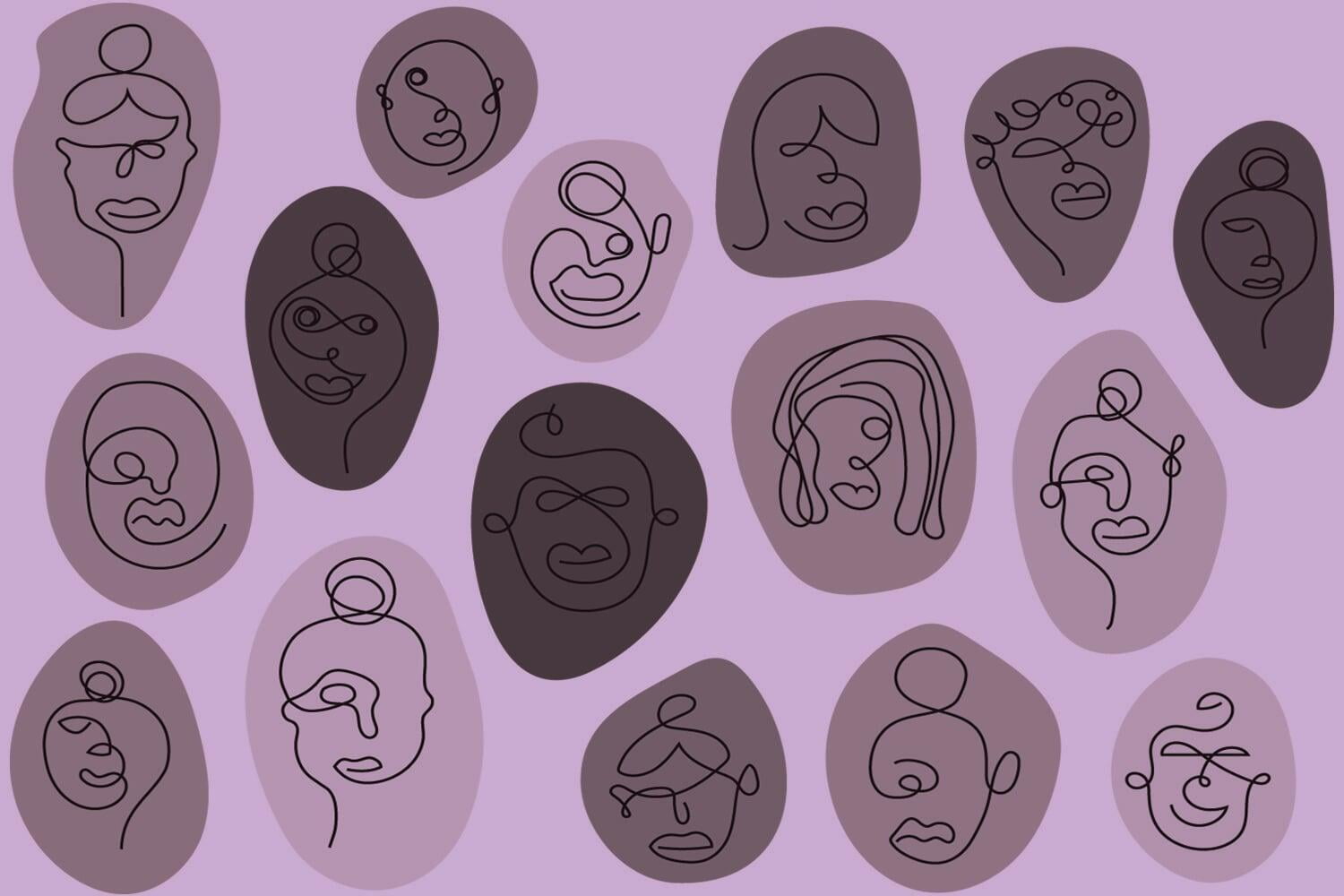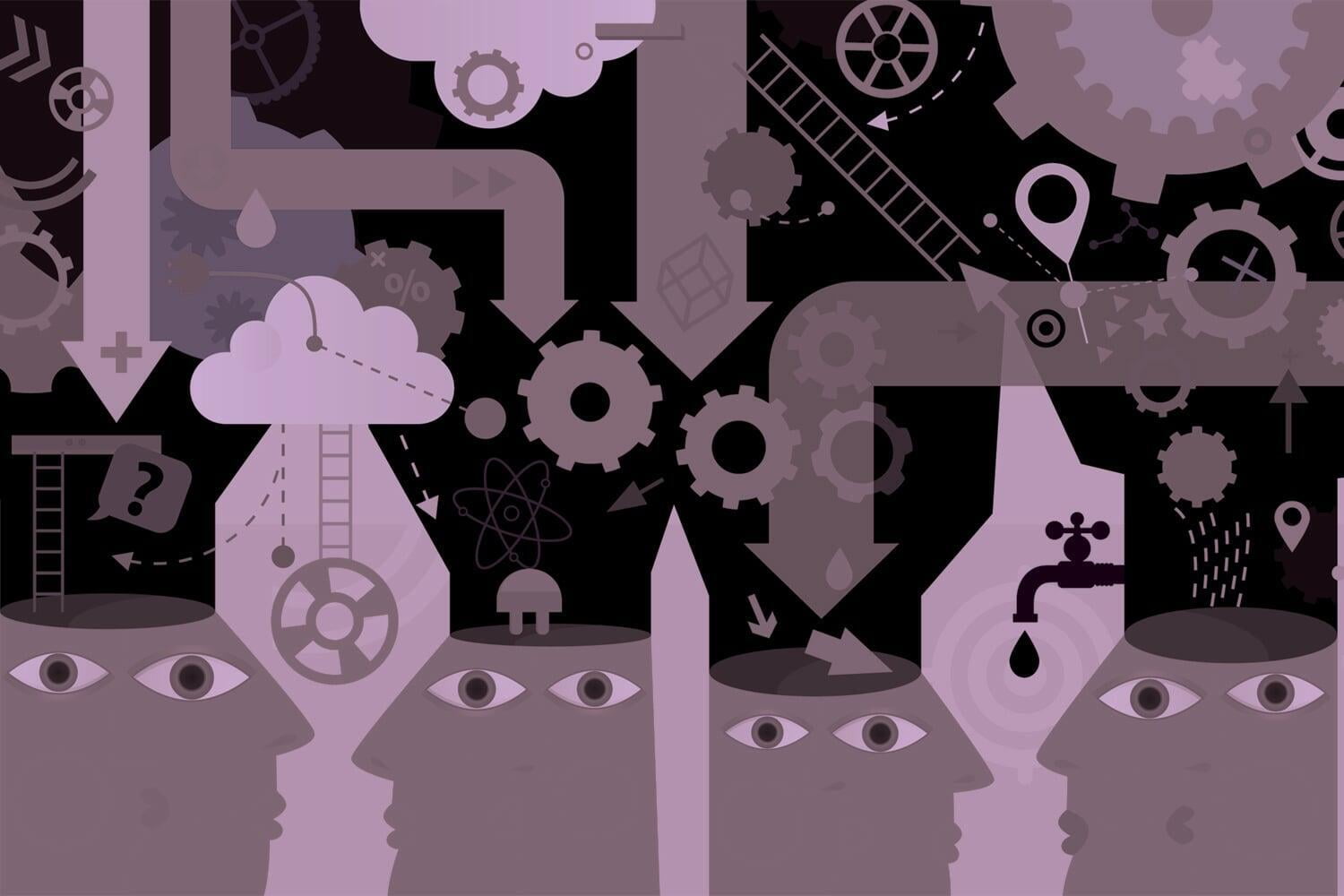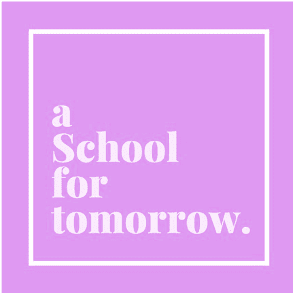The Way | Live | The Power of Relationship
Relationality In The Student Community Of Inquiry And Practice
The student community of inquiry and practice is typically focused on relationality.

We believe that students currently reveal themselves to be strong agents in their own education for character and competency in the following four ways:
-
Students are intentional, reflective, and engaged in the whole work of a school. By and large, the students who participated in this exercise show an unusual degree of reflective capacity. They show a high degree of character literacy. Agency is important to them.
- Students are relational. So much of student character learning is situated learning – forged through the vital relationships provided by their peers as well as their teachers in the school environment. This situated learning happens everywhere in the school. It happens largely in the social influences and interactions of the school, more so than in formal direct instruction or formal programs.
- Students have their own important situated community of inquiry and practice. Students in their schools participate in a community of inquiry and practice in character development. As the evidence makes abundantly clear, within the school environment, they rely on each other and indeed need one another to bear witness, to practice and to try out.
- Character development in students is intimately tied to processes of maturity and identity formation. While this is not a novel observation, it is important to remind ourselves that the values and character strengths the students tended to identify and experience are tied to the processes of maturity and identity formation. Further, this may be a valuable lens by which to understand how students engage with character education, and how they reflect on and direct their own character development.
It seems important to note that students are readily able to list and explain a range of character strengths they believed to be somehow significant to their learning and experience and which appeared to be the intentional focus of character education valued by their schools. No one said that character education, understood as broadly as possible, was not an active principle or of genuine concern at their schools. Moreover, many of these students certainly demonstrate what we might call ‘character literacy’ – the ability to articulate and reflect on their character development, and to describe at least some of the operations of character formation and the congruence of various ‘character words’ in their personal lives. But this is not universal, and even for the most articulate and reflective students, there are not many signs of a common or shared language, even at the individual school level, to help then mature and grow in their character development. While students valued their association with teachers across the range of activities and interactions in the school community, there is not much evidence in the students’ responses and stories of any well-organised or coherent feedback that might guide them in a way that makes sense to them.
It is also interesting to note that in most of these schools a diffusion of character strengths and these are most often only loosely wired to the stated and official core values or mission statements or mottos of the school – the kind that foreground a strategic plan or would provide direction. In some schools there would appear to be a much stronger correlation, but in most any resemblance is weak or not evident at all. It suggests to us, as we said earlier in an earlier chapter, that there is an almost universal ‘gap’ between stated intent and operational effectiveness and clarity of outcomes for students. On the positive side, perhaps, it also tells us that most students have a richer and more diverse character life in their school community than is understood, and that most students are for the most part actively engaged in it.
Students have much to say about effective and ineffective programs in their schools, and many could envisage how their schools could get better in providing support for character education and character development. Most of these are very school-specific observations and reflections on programs or activities. There is therefore no easy way to draw out from this testimony ‘best of class’ models of exemplary practices because they are so embedded in local circumstances and operation. However, the strands of positive and negative references woven through the students’ reflective accounts of effective and ineffective programs do help us to see a community of inquiry and practice in their experiences of character development in their schools. This notion of a community of inquiry and practice, as described below, might give some guidance to the design, execution and evaluation of various programs and initiatives in character education.
Let’s look especially at what students across the world said about relationality in their community of inquiry and practice. The following graphs below show that students across different types of schools see their extra-curricular activities and their key relationships with their peers and teachers as being the dominant sources of strong character education gains and the location of their most significant memories about character learning. Around a quarter are, by and large, satisfied with their experience and the remainder can point to dissatisfaction or suggestions for improvement across a range of different fields, with no one program or activity standing out in particular, but with clear mention for a desire for improved character learning in classrooms. Relatively few talked directly of an explicit need for increased agency, or talked significantly about agency as being dominant in their memories of character learning. Nonetheless, there was significant mention of agency and voice as an important feature of their other responses. Leadership may well fall into this category as well. Overall, it is clear that any assessment of the progression of character development must go hand in hand with the formation of identity and the social, cognitive and affective development of students.
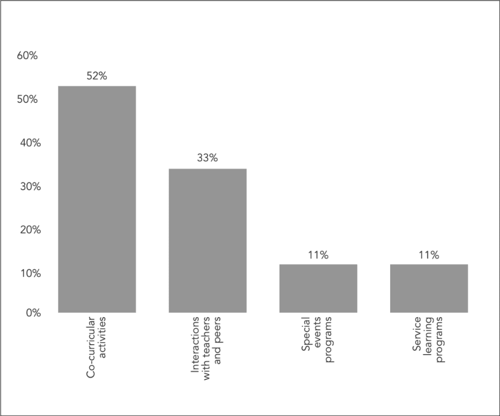
Programs or activities or interactions with people at school that are most effective in developing character qualities: senior student perspectives
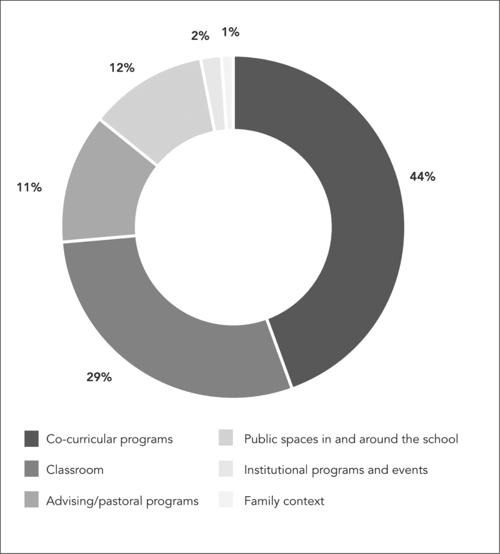
The settings for memorable occasions for character learning at school: senior student perspectives
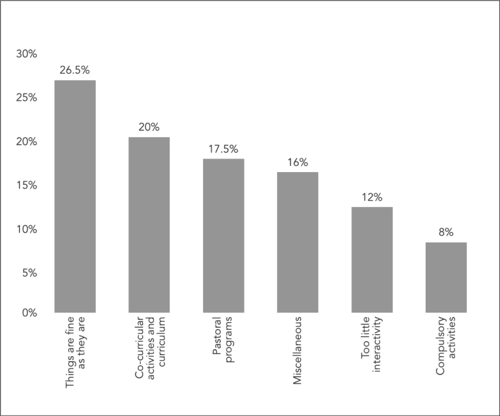
Programs or activities or interactions with people at school that are NOT very effective in developing character qualities: senior student perspectives
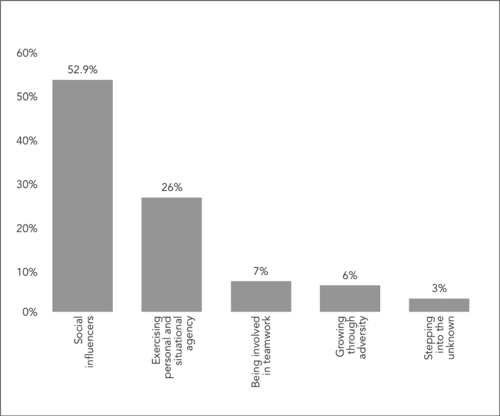
Types of memorable occasions for character learning at school: senior student perspectives
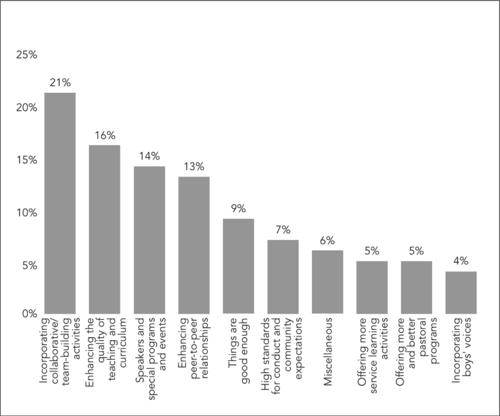
How schools might get better at character education: senior student perspectives
Taking these five graphs together, we should not be surprised that extra-curricular activity is seen as a more particular home for character development and that relationships are seen as critical in the methodology of character development. This corresponds to what teachers in senior schools currently talk to – that their focus on character development is less on formal, deliberate classroom instruction and more on what happens in other settings and around the school more generally. This does not mean that character learning is not happening in classrooms; the evidence of the students and our observation of schools suggests that it does occur all the time. But, given the lack of a common character education vocabulary and the preference for more implicit and spontaneous pedagogy among senior school teachers, it may well be the case that a broad definition and ostensible practice of character and character learning is not being shared. The students themselves want to see classroom-based character learning enhanced.
At the same time, the community of inquiry and practice in character education of the senior students is perhaps unsurprisingly focused on the extra-curricular side of school. Again, there is most likely a strong practice occurring in classrooms of which the students are not as cognisant. The lack of transparency and visibility cannot assist with the transmission of character education goals, nor can it support a view that practice is achieving such goals as consistently and with the degree of quality in the experience of every student as educators, parents and the community might desire. The coherence of character education, therefore, might be seen (at best) to be patchy.
It might seem unusual to talk about the community of inquiry and practice of the students, but we believe that it is an integral part of the way in which character education works in schools. As the evidence makes abundantly clear, within the school environment, students rely on and need one another to witness, explore and discover, practice and react to others, and reflect on their emerging character identity. They are, therefore, just much novices and experts with each other as they are with adults.
The first feature of this ‘community of inquiry and practice’ is where it takes place. In our IBSC research, students were asked to identify and tell the story of a ‘memorable moment’ in their experience of character growth at their schools. We found that in their accounts, so much of student character learning is ‘situated learning’, embedded in the overlapping networks and activities that comprise school life. One way or another, this situated learning is forged through the vital relationships provided by peers, and with adults, in the school environment. Moreover, situated learning in character development happens everywhere in the school, and it happens all the time. As the students make clear in their responses, it happens largely but not only through the medium of social influences and interactions among peers in particular, more so than through direct instruction or the formal content of curriculum and programs. But even the students are able to see that the classroom can be more universally a site of character education, and that in the skilled hands of many teachers, it already is.
Students like to see themselves as maturing experts, learning new skills through cycles of practice and reflection. We gain expertise or mastery in the work of building character in much the same way. Developing character strengths and competencies is profoundly an act of craftsmanship, with a kind of reflective practice at its core.
A second characteristic is that this community is intensely relational and social; the quality of relationships matter. In this research, we discovered in particular how foundational these relationships and social interactions are as a ground for the processes of character development. Frequently during the students’ accounts, the quality of these relationships and social interactions was stressed as essential to engagement with characters development. Some students told us explicitly that the power of these relationships and interactions as a foundation for character development is strengthened by cohesive school communities, positive peer relationships, and engaged teachers and leaders. Creating, repairing and sustaining a school environment that contributes to these positive relationships and interactions foundational to a community of practice is highly skilled ‘culture work’ on the part of leaders and teachers.
Another characteristic of this community of student inquiry and practice is found in the research we conducted about memorable moments or occasions. We discovered there the importance of what we named ‘personal and situational agency’ especially in the dynamic of those situations and ‘critical incidents’ that seemed, in significant or symbolic ways, to awaken character growth or maturity for many students. This agency played out in ‘structured activities’, designed by the ‘rules’ of the activity or by some sort of clever scaffolding, as well as in ‘unstructured’ activities – more informal and sometimes spontaneous or unexpected activities. In these activities, students are ‘doers’ more than ‘observers’. ‘Agency’ becomes important to us because it includes the notions of practice and performance. It seems that a sense of agency is very important to most students – they like to see themselves as emerging experts who are actively creating and consolidating their character strengths. They are decidedly not ‘tabula rasa’; they are engaged in a process of seeking out, testing, and clarifying their own repertoire of character strengths, and forging these into a coherent whole. These students like experiences where they can feel this sense of agency and control; they tend to dislike experiences or activities that feel constraining, inauthentic, ‘top down’ and disempowering.
A further characteristic of this community of inquiry and practice is that its natural medium is the processes of identity formation. A useful way to understand this is to observe how students are proceeding through phases of identity exploration – including the values, beliefs and character strengths they will uphold and activate in their lives and relationships. Following on from Erikson, James Marcia theorises that the adolescent goes through stages of identity formation, ending (for most of them) in early adulthood with some version of identity consolidation. In Marcia’s model, there are discernible identity states and operations involving foreclosure, identity diffusion, moratorium and identity achievement. One of the benefits of this identity framework is that it adds clarity to a definition of character education and its pedagogical operations. School activities of all sorts might be seen as intentional holding environments for character development, in which students are deliberately and skilfully ‘held’ to this work through a rich repertoire of ways of guiding, challenging and engaging them in the work of character.
Within this student community of inquiry and practice, it is important to note that it is practice towards something. We said above that students like to see themselves as maturing experts, learning new skills through cycles of practice and reflection. We gain expertise or mastery in the work of building character in much the same way. Developing character strengths and competencies is profoundly an act of craftsmanship, with a kind of reflective practice at its core. In fact, at least for character education, the job of a school seems to be to create the conditions that support students in their journey towards mastery. This expertise and mastery model, we think, also helps to make sense of the steps or stages involved in character growth as much as in the acquisition of any other competency.
We note elsewhere that there does not appear to be hugely significant differences between early and late adolescents in the clusters of character strengths reported or in the types of narratives recounted in the ‘memorable moment’ exercise. However, it is possible to discern a continuum – early adolescents tend to be more concrete and perhaps more self-interested than older students, whose expositions show a level of reflection, discernment and context. Of course, this continuum would not be progressively one- directional. As the identity theorists suggest, there are starts and stops, reversals and surges, confusion and doubts along the way – and this is so in any journey towards any expertise. We posit that student character education, as understood as a journey towards expertise, would gain much by the provision of a more visible and accessible conceptual and competency-based language which they could use to help them understand their own growth as persons of character, and to gain expertise and mastery of their own competencies.
